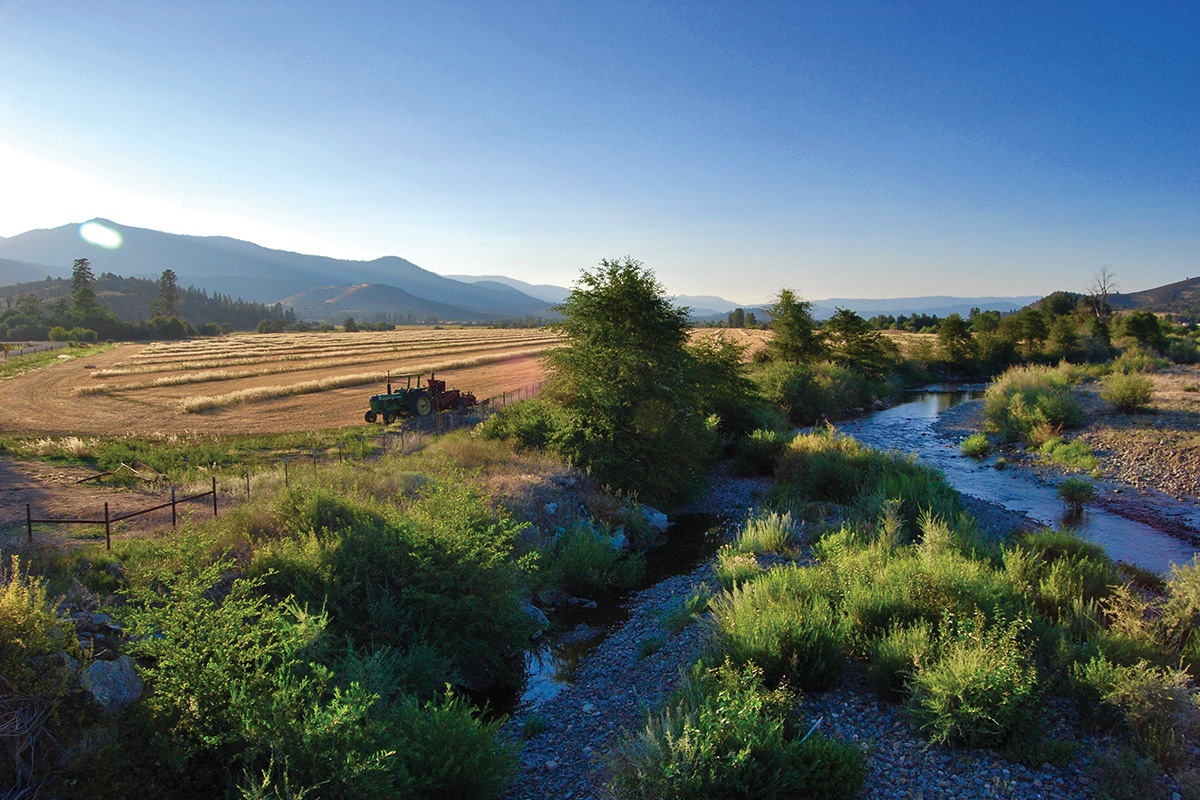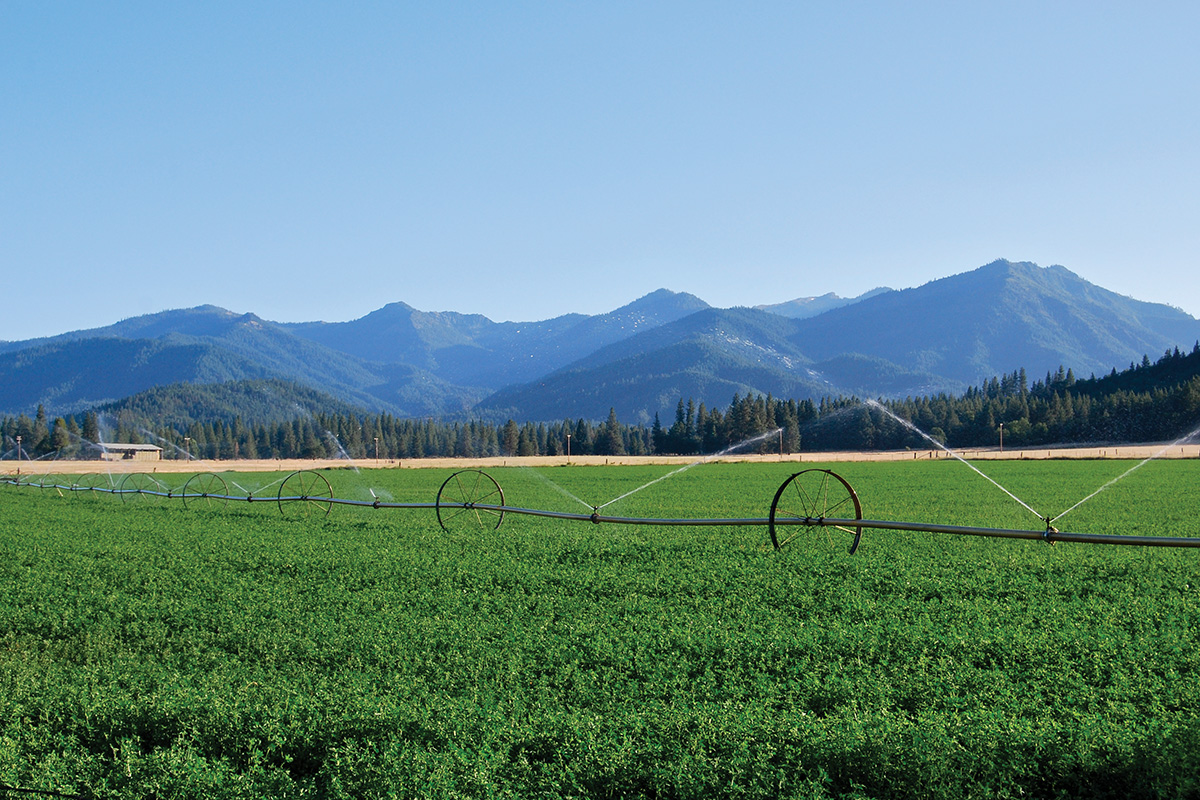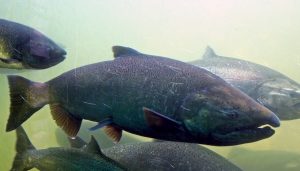A drought swept through California in the early 1990s. I remember my second-grade teacher painting a bleak picture to our class about how we could literally run out of water, and that there might not be enough for people and fish alike. As a young child, what I took away was apocalyptic: images of fish stranded ashore because people were using too much water.
That day, I ran home from school, on a mission. I didn’t even bother dropping off my backpack inside. I went straight to the hose in our front yard and dragged it to the street, where there was a storm sewer with a sign that read, “No Dumping, Drains to Bay.” A fish was painted alongside the warning to emphasize the point. I stuffed the hose into the storm sewer and turned it on full blast. I was giving some of our water to the fish. While I didn’t know it at the time, that was the first of many water transfers I would facilitate.
Decades later, droughts continue to plague the West. They’ve become so normal that they now require new terms like “megadrought” and “aridification.” When the West faces water shortages, no one is spared: habitats degrade, food and electricity production take hits, communities are choked by relentless wildfires. The repercussions of droughts will intensify as they occur more regularly and with more severity amid climate change.
Today, as a water economist, my job is to help customers stretch their limited water resources. This means managing supplies wisely and getting a handle on collective demands. Fortunately, one of our available tools is an old one: water markets that can help reallocate the resource to the places it’s needed most.
I’ve learned a lot more about water and water markets since I was a second-grader determined to help fish in the San Francisco Bay. One lesson is that even well-intentioned water markets can have bad outcomes if poorly designed or executed, as was my first water transfer. After a decade in this industry, I’ve seen great water markets and failing ones. They’re often grouped together, mischaracterized, and misunderstood, muddling the record on water markets in the western United States.
What Water Markets Are
In the arid western United States, there simply isn’t enough water to meet every water demand. For decades, water markets have been an important tool that helps westerners reallocate their limited water to higher-value uses through voluntary, compensated agreements. Importantly, there is no single water market in the West—there are hundreds, ranging from informal to formal, operating at a hyperlocal level.
At its core, a water trade entails transferring some or all of a water right to another party, typically in a way that changes its place or purpose of use. Voluntary, market-based transfers reallocate water to where and when it’s most needed, in the process helping to produce more with less, facilitate better environmental outcomes, and cope with drought and climate change.
Voluntary, market-based transfers reallocate water to where and when it’s most needed, in the process helping to produce more with less, facilitate better environmental outcomes, and cope with drought and climate change.
The concept of “most needed,” however, is always evolving. Drought and climate change are altering the timing and quantity of western water supplies. Water demands change as a result of shifting community needs, global market conditions, and cultural values. For example, urbanization has led many municipalities to acquire water for city use. Consumer demand for high-value crops like tree nuts, hops, and apples has led to shifts in water use within the agricultural sector. Increased public support for healthy ecosystems has led to more purchases that keep water in rivers and streams to support wildlife habitat. Demands for water use change within and between sectors; the ability to reallocate water to adapt to those changes is imperative. Without trading, water would be locked into a particular place, time, and purpose that could not adapt to meet changes in supply, local community needs or values, or global market conditions.
I first got the chance to learn all about water markets in graduate school. As part of my research, I interviewed some 100 farmers and water managers across the West over eight weeks, traveling many less-traveled dirt roads. I learned that there was much more activity and breadth in water trading than our research team had previously known. I also learned about the very real barriers that formal water markets erect for farmers, and how those barriers—not the price of water—can make water trading unaffordable to the average farmer. Eventually, my thesis advisor and I started Mammoth Water, the company we now run in an effort to make water markets more affordable, accessible, and equitable.
Seven years later, I still travel many dirt roads, working closely with farmers and water managers from Kansas to California to understand the particular challenges they face. Farmers struggle to find interested trading partners, negotiate prices, and navigate complex regulatory frameworks—tasks for which they typically hire real estate agents, engineers, and attorneys. Regulators, on the other hand, spend substantial time and effort reviewing applications to trade water. Trading rules are complicated enough that, in some instances, we found regulators had made mistakes and approved trades that did not conform to their own rules, potentially harming other water users or the environment.
The bulk of water trading happens between agricultural producers, who trade water to manage irrigation requirements and cope with shortages.
All of these reasons were the impetus for us to create the first “smart markets,” or electronic clearinghouses, for water trading in the United States—centralized hubs for trading activity that automate the process of matching parties by both price point and regulatory constraints. We’ve helped customers transfer water to more productive lands, with lower environmental impact, at a fraction of the time and cost than before. Matching many parties with one another is difficult to organize by hand; with a smart market, it’s effortless.
While smart markets for water are new in the United States, water markets are not. Yet in the West, they’re usually informal and decentralized, as we documented in a 2019 report. Many trades are done at the local level and sealed with a handshake between farmers. Formally reported water trades represent a fraction of the total volume and value of water traded annually. We have little idea about how much water is being traded in aggregate, or what value water markets are creating, across the country. And while we don’t know the exact breakdown, the bulk of water trading happens between agricultural producers, who trade water to manage irrigation requirements and cope with shortages.
What Water Markets Are Not
Despite their long history in western management, water markets are plagued by pervasive misconceptions and are regularly misrepresented in the media. They’re dubbed new tools for the rich to speculate on water, manipulate its value, and sell to the highest bidder. The truth couldn’t be further from this mischaracterization. In reality, water markets help communities cope with scarcity, allowing users to reallocate a limited resource as needed.
In December 2020, the Nasdaq Veles California Water Index futures launched. The idea, similar to commodity futures, is to hedge risk in price volatility by locking in a price today. In this futures contract, the price would be that of the index. If the index price goes up, the holder of the futures contract would pocket the difference and could put the proceeds toward the purchase of real, wet water. If the index price goes down, the holder would owe the difference but would be able to purchase real, wet water at a lower going market price.
Unlike commodity futures, however, the Nasdaq “water futures” do not require delivery of the commodity—wet water. Instead, the futures contracts are financially settled based on the index. The use case above presumes that the price of wet water that the user would need is closely correlated with the Nasdaq Veles California Water Index. But water pricing is idiosyncratic, depending on location, purpose of use, infrastructure, reliability, and other characteristics. For instance, the direction and magnitude of price shocks felt in some areas are different than in others, even within the same state or region. Further, the index is based on partial and proprietary pricing data from only five of California’s many dozens of local water markets. It’s unlikely, therefore, that the futures will be a useful tool for participants in real water markets in California or across the West. In reality, the futures market is not a wet water market at all—it’s more a tool to make “paper water” bets on California’s drought conditions.
A month later, in January 2021, an article from The New York Times portrayed investors attempting to financially exploit water rights in the Colorado River Basin. Among other things, the reporting pushed the idea that hedge funds were buying up undervalued agricultural water rights, which they could hoard in federal reservoirs, eventually selling water to the highest bidder once its value peaked in a time of distress. It’s not a new storyline about water markets. While such sensational stories generate buzz and clicks, they fail to acknowledge the pillar of western water policy that was built to prevent speculation: the beneficial use doctrine.
In the United States, water is the property of the people of each state, held and administered in trust by the appropriate state agency. No one “owns” water; instead, the ownership right is in the use of the water, called a usufructuary right. Western water law was further built on the beneficial use doctrine—rights to use water come with the caveat that they must be beneficially used. Using water rights in a way that is not considered beneficial could subject them to relinquishment. Of course, the definition of beneficial use is an evolving concept. Leaving water instream to improve habitat, for instance, is not recognized as a beneficial use everywhere, a regulatory reality that can hamper conservation efforts. Yet while definitions of beneficial use vary state to state, holding water for future financial gain is not a recognized beneficial use across the West. Speculating on water in the West is illegal.
Trading Friction
In the trading of real, wet water, farmers, conservationists, or anyone else looking to trade is likely to come across plenty of challenges. At practically every step in the process, a person looking to trade water will encounter an obstacle that imposes transaction costs in time, money, or effort. They’ll need to determine how much water to trade, an increasingly difficult task given the effects of climate change. They’ll need to identify an interested party with which to trade. Most contact their neighbors, family members, and friends, although some work with specialized water attorneys and brokers. Some areas have legal pads, or bulletin boards, that act as water listings. Some even post their water for sale on Craigslist.
After finding one another, the parties will negotiate contract terms, sometimes a prickly task as both sides typically know one another. And finally, in a formal transaction, they’ll submit a transfer application to the appropriate regulator—a loose term that, depending on the community or basin, could refer to a state or local public agency, a court, or a water or irrigation district.
While each of these steps adds costs for water market participants, the last step—the one involving regulatory review—has a huge amount of variability. A potential transfer not only depends on the review process of the applicable regulatory agency, but also whose desk it lands on.
Water trading regulations should be as complex as necessary. After all, our watersheds, aquifers, and the activities they support are complex. They are also unique, so there is not and cannot be a one-size-fits-all solution for water trading regulations. The groundwater trading programs in the Platte River Basin of Nebraska, for instance, where stream depletion is the primary concern, look much different than the program being developed in Rosedale-Rio Bravo in California, an area with significant potential for groundwater recharge. Even within the Platte River Basin, trading programs differ from one district to another.
In the trading of real, wet water, farmers, conservationists, or anyone else looking to trade is likely to come across plenty of challenges. At practically every step in the process, a person looking to trade water will encounter an obstacle that imposes transaction costs in time, money, or effort.
While local considerations are crucial, complexity does make it difficult for water users to understand and navigate the regulatory process for transfers. This is particularly evident when regulators fail to clearly define the criteria for approving transfers. Many still rely on case-by-case evaluation, which can lead to arbitrary and inconsistent rulings.
At Mammoth Water, regulatory unpredictability makes our work difficult. We match buyers and sellers in customized smart markets that consider both price point and regulatory constraints—but we have to know what the regulations are. The rules must be specific and clear, lending themselves to automation. Otherwise, we cannot tell a computer how to evaluate potential trades. We’re leveraging automation to reduce transaction costs, but we need the public sector to do its part.
Codifying water transfer criteria, which we constantly advocate at Mammoth Water, is the single thing that regulators could do to lower transaction costs most. Clear and specific criteria provide more transparency to water market participants from the outset, formalizing the legal and technical standards for a thumbs-up or a thumbs-down. Such clarity would increase the quality of transfer applications that a regulator receives, as well as streamline and systematize decision-making.
Markets for Conservation
Stewardship is Mammoth Water’s primary company value. And well-designed water markets are an important tool for water stewardship. To begin with, water markets create a new revenue stream for water savings and conservation, rewarding good stewardship. This encourages more efficient water use, putting scarce and under-utilized water to better, more productive purposes.
An active and successful participant in western water markets is a seemingly unlikely one: the environmental sector. Water trusts and nonprofits across the West—in Arizona, California, Colorado, Nebraska, Oregon, Washington, and elsewhere—regularly acquire water through a combination of temporary and permanent transfers. Their leases and purchases supplement and retime instream flows, creating better environmental outcomes through voluntary, market-based transactions.
In Nebraska, the Platte River Recovery Implementation Program has acquired a combination of surface water and groundwater rights for the benefit of endangered species, including the whooping crane, piping plover, and pallid sturgeon. In recent years, the program has adapted its strategy to lease surface water rights that can be stored in Lake McConaughy, a federal reservoir, giving greater control to retime releases in a way that most improves habitat downstream. This year, the program is leasing nearly 40,000 acre-feet of water.
Since 1978, the Arizona Land and Water Trust has used market-based transactions to improve holistic land and water management practices in southern Arizona. Its agreements with landowners include conservation easements, short-term water leases that encourage fallowing, conversion to crops that use less water, and modernization of equipment and infrastructure. The trust has a long track record of preserving land with particular importance to wildlife, protecting more than 60,000 acres.
Water markets create a new revenue stream for water savings and conservation, rewarding good stewardship. This encourages more efficient water use, putting scarce and under-utilized water to better, more productive purposes.
In Washington State, Trout Unlimited has developed an impressive portfolio to boost streamflows for two federally listed species: steelhead in the Yakima River and Chinook in the Methow. The group has worked with landowners on a range of agreements, from drought-year leases to permanently repurposed water rights for instream flows. It has also worked collaboratively with growers and irrigation districts to boost efficiency and update operations that improve conditions for fish.
Mammoth Water is supporting Trout Unlimited, Kittitas Reclamation District, and the Yakima Basin Integrated Plan to build on their joint success creating multi-benefit water management practices in the Yakima Basin. Our ongoing project, funded by the Bureau of Reclamation and Washington Department of Ecology, will develop a smart market strategy that would generate benefits to both farmers and fish by streamlining downstream trades.
These are a handful of success stories that have many parallels. Local, state, and national environmental organizations are not just active but innovative participants in water markets. And they are well versed in what it takes to make water trades happen: deep expertise at the local level, boots-on-the-ground engagement, and pure grit.
Coping with the Future
Well-designed water markets help manage changing water supplies and demands. They help communities cope with water scarcity in the short term and evolving demands in the long term. They create a new revenue stream for water users, who can monetize their water savings and invest in conservation practices and technologies. Those who decry or wish to do away with water markets ignore the important role they play in adaptation and resilience, including to supply-side dynamics that we’ve felt through drought, aridification, and climate change.
If you asked me today, “Are water markets good or bad?” I would ask you, “Which water market?”
But water markets are not foolproof. They rely on good governance from regulators, which requires transparency, trust, and inclusivity. They must reflect community needs and local hydrologic relationships, preventing harmful if unintended impacts to third parties. Unfortunately, not all water markets meet these criteria, which could make them unfair or vulnerable to abuse or exacerbate scarcity conditions.
If you asked me today, “Are water markets good or bad?” I would ask you, “Which water market?” There’s a lot of nuance in what makes good water market design. In many instances, tracking how water markets perform is lacking. Better analysis of water trading volumes and outcomes could identify which rules are making an impact, good or bad, on environmental and socioeconomic outcomes. Local communities and water professionals could learn from that analysis and leverage the insights to improve market design and performance.
Stories about communities running out of water or Wall Street buying up the West’s water make our anxiety spike—as they should. We should desire to be fierce stewards of the water our communities depend on; after all, that’s the story of my first water memory. But my hope is that, like with my own journey, others will dive deeper to explore the real water scarcity issues on the horizon and what we can do to start to resolve them. People should be informed about and empowered in water governance, whether they’re farmers who irrigate their crops, households who want clean and reliable water from their taps, or children who simply want to share their water with fish.








